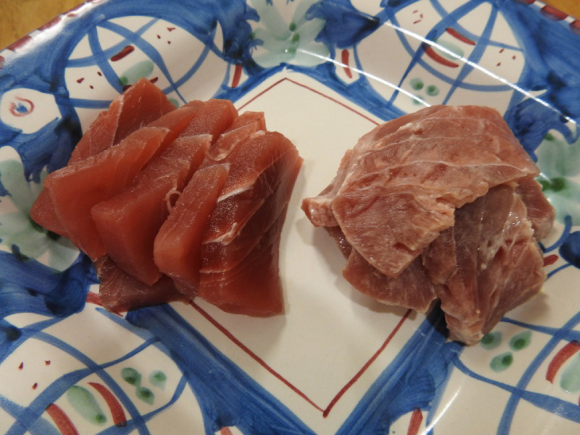
Being one of Japan’s two favorite types of fish to eat raw, Japan takes its tuna pretty seriously. As a matter of fact, tuna sushi and sashimi gets different names depending on which cut of the fish is being served. While just about everyone loves ordinary tuna, either maguro or akami in Japanese, it’s the extra-fatty tuna belly, called chu-toro or o-toro, that people really rave about.
Of course, those same premium cuts that get gourmands’ mouths watering can leave your wallet crying, as the price of the extra-creamy toro can be more than double that of lesser cuts of tuna. That’s why we decided to test a theory we’d heard that you can unlock the full potential of akami with mayonnaise. But does marinating your ordinary tuna in mayo turn it into toro, or is this rumor just a bunch of bull?
With our curiosity piqued and our appetites stimulated, we headed to the grocery store to pick up some akami sashimi and mayonnaise.
▼ See that half-off sticker on the sashimi package? We told you going to the supermarket in Japan late at night is awesome!
This trick isn’t as simple as just dipping your slices of akami into a plate of mayo like it was soy sauce, though. Following the method we’d heard about, first we laid out a large sheet of plastic wrap and slathered it with mayonnaise. Then we wrapped the akami sashimi in it and stuck the bundle in the refrigerator to sit for three hours.
▼ If you can get your hand on some, you might want to use Japanese-style mayonnaise, which is a bit less watery and creamier than Western varieties.
Three hours later, we pulled the package back out of the fridge, unwrapped it, and wiped the excess mayo off of the fish with a paper towel. Our sashimi certainly looked different after its day-spa like mayo wrap, with a paler color much closer to that of toro than the bright red our akami (which literally means “red body”) started out as.
▼ Original akami on the left, post-mayo treatment akami on the right, hungry RocketNews24 staff behind the camera.
Anxious to find out if a similarly dramatic transformation had taken place in the flavor department, we took a bite, and found that if it wasn’t necessarily an exact match, it was definitely toro-like, in both flavor and texture.
Still, when it comes to food, we’re not just cheap, we’re picky too. Even though we’d wiped most of the mayo off before eating, there was still a trace of the condiment left in the slight sogginess it imparted to the sashimi. Oh, and we’re lazy too, so we really wanted to find a way to get around all that wrapping and unwrapping.
Thankfully, we forced ourselves to be industrious just long enough to think of a solution. To test it out, we decided this time to use katsuo (bonito), because it’s even less expensive than akami per kilogram, and it was also half-off at the grocery store.
Instead of bothering with the plastic wrap, we tossed our katsuo sashimi in a mixing bowl and added a little bit of mayo at a time, giving the slices an even coating. Overall, we used less of the condiment than we had with the first method, so we decided to let it marinate for an extra-long time and stuck it in the fridge for five hours rather than three.
This follow-up experiment turned out to be a huge success, with a great flavor and texture. Since we’d already had so much regular sashimi, we decided to make some hand rolls with seaweed, green onions, and sesame seeds. The result tasted so good that we think we might even be able to serve it to guests to our home and tell them it’s chu-toro in order to impress them with our generosity.
As long as we remember to whip up a batch before they come over, that is.
Photos © RocketNews24
[ Read in Japanese ]